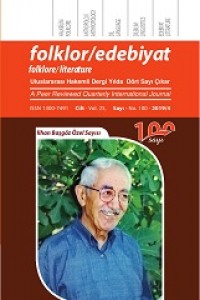Öz
The aim and scope of this research was to discover the games appreciated by
Turkish Sephardic, American Sephardic and Turkish Muslim female children in
the 1950s, their environmental teachings, and transnationalism. Old people teach
children games, which can also be transnational and narrated in other countries.
Oral history interviews were conducted with these three groups of women, and they
were asked about the metaphors in their childhood games. These informal chats also
led to the discovery of some games played by female children. Similarities of these
metaphors were used to suggest a peace building theory based on environmental
humanities. Accordingly, the metaphorical concepts in female children’s games
were analyzed through the conceptual metaphor theory developed by Lakoff and
Johnson (1980) for deciphering their environmentalist teachings and their impacts
on the formation of children. As the transnational nature of games makes one
understand that children would play together regardless of their creed and ethnicity
in the 1950s, such games are recommended to be taught to today’s children who
rarely play games outside their houses with other children. As a result of this study,
it was found that conceptual metaphors based on the protection of the environment
were similar in certain games regardless of children’s cultural backgrounds. The conceptual metaphors of “NATURE IS A MOTHER,” “ANIMALS ARE LOVE,”
and “NATURE IS A SHELTER” were commonly used in these children’s games,
and these similarities should be taught children by encouraging them to recognize
and adapt the concept of unity in diversity. Consequently, the crimes committed
by children against animals should be prevented, and children should learn the
ways to preserve the environment and nature easily without damaging any plants
or animals. It is crucial to teach children similar games with similar elements
are played in different parts of the world. In these games, similar environmental,
educative, and metaphorical objects and word games may also be used.
Anahtar Kelimeler
environmental education ecocriticism transnationalism childhood games
Kaynakça
- Agiş, F. D. (2007). A comparative cognitive pragmatic approach to the Judeo-Spanish and Turkish proverbs and idioms that express emotions. (Master’s thesis). Hacettepe University, Ankara, Turkey.
- Burbery, T. J. (2012). Ecocriticism and Christian literary scholarship. Christianity and Literature V. 61(2), pp. 189-214.
- Feder, H. (2014). Ecocriticism and the idea of culture: Biology and the bildungsroman. Ashgate Publishing Company: Burlington, VT, U.S.A.
- Jones, A. (1998). 104 activities that build: Self-esteem, teamwork, communication, anger management, self-discovery, and coping skills. Richland. (Paperback – 1 Jan 1998). Richland, WA: Rec Room.
- Kroeber, A. L. (1940). Stimulus diffusion. American anthropologist V. 42 (1), pp. 1-20.
- Lakoff, G., and Johnson, M. (1980). Metaphors we live by. Chicago: University of Chicago . Masal.org. (2019). Göle yoğurt çalmak fıkrası. Retrieved from https://www.masal.org/gole-yogurtcalmak- fikrasi.html.
- Oren, A. (2008). The use of board games in child psychotherapy. Journal of Child Psychotherapy, V. 34 (3), pp. 364–383.
- Shaul, E. (1994). Folklor de los Judios de Turkiya. Isis: Istanbul.
- Elektronic resources
- Eifermann, R. R. (1968, June). School children’s games. Final report. Jerusalem: Hebrew University of Jerusalem (Israel). Retrieved from: https://files.eric.ed.gov/fulltext/ED024061.pdf.
- Harris, I. M. (2002, April 1-5). Peace education theory. Paper presented at the 83rd American Educational Research Association. New Orleans, LA. Retrieved from https://archive.org/stream/ERIC_ ED478728/ERIC_ED478728_djvu.txt.
- Issitt, M. (2015). Ecocriticism. Salem Press Encyclopedia of Literature Research Starters, EBSCO host (accessed October 23, 2016).
- Sansal, B. (2005). About Turkey. Retrieved from http://www.allaboutturkey.com/nasreddin.htm
Ayrıntılar
| Birincil Dil | İngilizce |
|---|---|
| Konular | Türk Halk Bilimi |
| Bölüm | Derleme Makaleleri -Compilation Articles |
| Yazarlar | |
| Yayımlanma Tarihi | 22 Kasım 2019 |
| Yayımlandığı Sayı | Yıl 2019 Cilt: 25 Sayı: 100 |
Derginin yayım dili Türkçe ve İngilizce’dir, ayrıca Türkçe de olsa tüm basılan makalelerin başlık, öz ve anahtar sözcükleri İngilizce olarak da makalede bulunur. Hakemlerden onay almış Türkçe makaleler için 750-1000 sözcükten oluşan genişletilmiş özet (extended summary) gereklidir. Elektronik çeviriler kabul edilmez.
Dergi TR-Dizin, Web of Science (ESCI), DOAJ ile diğer pek çok dizin tarafından taranmaktadır. Scimagoe quartile değeri: Q2 'dir:
TR DIZIN 2020 Etik Kriterleri kapsamında, dergimize 2020 yılından itibaren etik kurul izni gerektiren çalışmalar için makalenin yöntem bölümünde ilgili Etik Kurul Onayı ile ilgili bilgilere (kurul-tarih-sayı) yer verilmesi gerekecektir. Bu nedenle dergimize makale gönderecek olan yazarlarımızın ilgili kriteri göz önünde bulundurarak makalelerini düzenlemeleri önemle rica olunur.
Alan Editörleri/ Field Editörs
Halkbilimi/Folklore
Prof.Dr. Hande Birkalan-Gedik (JohannWolfgang-Goethe İniversitet-birkalan-gedik@m.uni-frankfurt.de)
Prof.Dr. Ali Yakıcı (Gazi Üniversitesi-yakici@gazi.edu.tr)
Prof.Dr. Aynur Koçak (Yıldız Teknik Üniversitesi-nurkocak@yildiz.edu.tr)
Prof.Dr. Işıl Altun (Regensburg Üniversitesi/Kocaeli Üniversitesi-İsil.Altun@zsk.uni-regensburg.de)
Doç.Dr. Ahmet Keskin (Samsun Üniversitesi-ahmet.keskin@samsun.edu.tr)
Edebiyat/Literature
Prof.Dr. Abdullah Uçman (Mimar Sinan Güzel Sanatlar Üniversitesi -emekli-29 MayısÜniversitesi-abdullahucman@29mayis.edu.tr
Prof. Dr. Ramazan Korkmaz (Ardahan Üniversitesi-emekli-Kafkasya Üniversiteler Birliği -KÜNİB-r_korkmaz@hotmail.com)
Prof.Dr. Emel Kefeli (Marmara Üniversitesi-emekli-İstanbul 29 Mayıs Üniversitesi-ayseemelkefeli @gmail.com)
Prof.Dr. Zekiye Antakyalıoğlu ( İstanbul Aydın Üniversitesi-zekabe@hotmail.com)
Antropoloji/Anthropology
Prof.Dr. Hanife Aliefendioğlu (Doğu Akdeniz Üniversitesi-hanife.aliefendioglu@emu.edu.tr)
Prof. Dr. Şebnem Pala Güzel (Başkent Üniversitesi-sebnempa@baskent.edu.tr)
Prof.Dr. Derya Atamtürk Duyar (İstanbul Üniversitesi-datamturk@istanbul.edu.tr)
Prof.Dr. Meryem Bulut (Ankara Üniversitesi-meryem.bulut@gmail.com)
Dil-Dilbilim/Language-Linguistics
Prof.Dr. Nurettin Demir (Hacettepe Üniversitesi-demir@hacettepe.edu.tr)
Prof. Dr. Aysu Erden (Maltepe Üniversitesi-aysuerden777@gmail.com)
Prof.Dr. Sema Aslan Demir (Hacettepe Üniversitesi-semaaslan@hacettepe.edu.tr)

